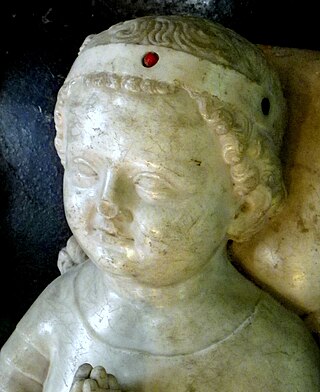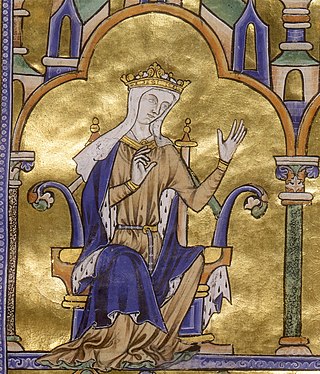
John I, called the Posthumous, was King of France and Navarre, as the posthumous son and successor of Louis X, for the four days he lived in 1316. He is the youngest person to be king of France, the only one to have been king from birth, and the only one to hold the title for his entire life. His reign is the shortest of any undisputed French king. Although considered a king today, his status was not recognized until chroniclers and historians in later centuries began numbering John II, thereby acknowledging John I's brief reign.

Blanche of Castile was Queen of France by marriage to Louis VIII. She acted as regent twice during the reign of her son, Louis IX: during his minority from 1226 until 1234, and during his absence from 1248 until 1252.
Guillaume Guiart was a French chronicler and poet.
Rigord (Rigordus) was a French chronicler. He was probably born near Alais in Languedoc, and became a physician.
William the Breton, French chronicler and poet, was a contemporary and dependent of French king Philip Augustus for whom he served in diplomatic missions and for whom he wrote a Latin prose chronicle and a Latin epic poem.
Ernoul was a squire of Balian of Ibelin who wrote an eyewitness account of the fall of Jerusalem in 1187. This was later incorporated into an Old French history of Crusader Palestine now known as the Chronicle of Ernoul and Bernard the Treasurer, often abbreviated Ernoul-Bernard. The chronicle covers the years from 1100 until 1228. A few manuscripts copied for Bernard, treasurer of Corbie Abbey, extend the narrative down to 1232.
Jean de Venette, or Jean Fillons was a French Carmelite friar, from Venette, Oise, who became the Prior of the Carmelite monastery in the Place Maubert, Paris, and was a Provincial Superior of France from 1341 to 1366. He is the author of L'Histoire des Trois Maries, a long French poem on the legend of the Three Marys, giving his name at the start of the text, and has since 1735 been also regarded as the author of an anonymous Latin chronicle of the period of the Hundred Years' War between England and France. In recent decades it has been questioned whether these were in fact the same author, although it seems that both were Carmelites. Other historians see no reason to create an extra author, but recent French publications tend to refer to the "Chronique dite de Jean de Venette". By his own account the chronicler was of peasant origin, and his view of the events of his lifetime has a significantly different perspective from that of other chroniclers.

The Grandes Chroniques de France is a vernacular royal compilation of the history of the Kingdom of France, most manuscripts of which are luxury copies that are heavily illuminated. Copies were produced between the thirteenth and fifteenth centuries, the text being extended at intervals to cover recent events. It was first compiled in the reign of Saint Louis, who wished to preserve the history of the Franks, from the coming of the Trojans to his own time, in an official chronography whose dissemination was tightly controlled. It was continued under his successors until completed in 1461. It covers the Merovingian, Carolingian, and Capetian dynasties of French kings, with illustrations depicting personages and events from virtually all their reigns.
The Recueil des historiens des croisades is a major collection of several thousand medieval documents written during the Crusades. The documents were collected and published in Paris in the 19th century, and include documents in Latin, Greek, Arabic, Old French, and Armenian. The documents cover the entire period of the Crusades, and are frequently cited in scholarly works, as a way of locating a specific document. When being quoted in citations, the collection is often abbreviated as RHC or R.H.C..
Robert VII de Béthune was a nobleman from the House of Bethune from Artois. He served as a knight and military leader in Flanders and England before inheriting his family territories in France and the Low Countries. He joined the Seventh Crusade, but died en route to the eastern Mediterranean.

The Annals of Vendôme are a set of medieval annals covering events from 678 to 1347. They survive in a single manuscript copy, the exemplar of which came from the Abbey of the Holy Trinity at Vendôme.
The Seneschal of Périgord was an officer carrying out and managing the domestic affairs of the lord of the County of Périgord. During the course of the twelfth century, the seneschalship also became an office of military command.

Primat was a French Benedictine monk and historian of the abbey of Saint-Denis near Paris. He composed two histories of France with a royal focus, one in Latin and the other in Old French. His Latin chronicle covers the years 1248 to 1277 but now survives only in an Old French translation and in excerpts incorporated into the works of others. It contains a detailed account of the reign of Louis IX, making it one of the most important contemporary sources for that reign. His French chronicle, the Roman des rois, covers the entire history of France down to 1223. It was completed around 1274 for Philip III and its presentation copy is extant. It is the earliest version of what would become the Grandes Chroniques de France, the first official history of France.
Nicholas of Bray was a French clergyman and poet who wrote a Latin epic on the deeds of King Louis VIII of France (1223–1226), the Gesta Ludovici VIII.
The Great Chronicle of Limoges, also called the Chronicle of Saint-Martial of Limoges, is a collection of 13th- and 14th-century historical notices and chronicles of Limoges preserved in three related manuscripts. Beginning in the 18th century, the material in the manuscripts was mistakenly perceived as fragments of a single large chronicle of the abbey of Saint-Martial. They were first critically edited as a unified chronicle in the 19th century. They are today recognized mostly as notes made by the monks of Saint-Martial as continuations of the copious historical notes made by Bernard Itier.




